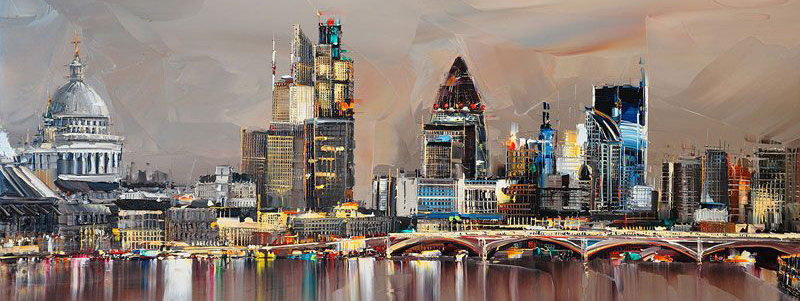Mayfair - Regent street and the surrounding area - Soho
If you asked a foreigner to name the first place in the city that springs to mind, the answer would probably be Piccadilly. The name not only stands for the square and the fountain at its centre, but also indicates the long street that heads westward and runs along the side of Green Park. During summer Sundays, it is really rather pleasant to spend the morning walking along its gentle slope until one reaches the park.

The origin of the name (hearing Mediterranean people pronounce it is an immediate give away as to their origin) comes from the profession of one of its first inhabitants, Robert Baker. The latter was a tailor who in the early Seventeenth Century, had a shop on the street and there he would sell pickadils, the scalloped cutwork for collars, similar to those worn by Shakespeare in portraits of the man. The nobility started to build their houses there, being surrounded at the time by fields, and simultaneously merchants began to open the first shops. Today Piccadilly is the most important artery of communication towards the western side of the city.
PICCADILLY CIRCUS
UNDERGROUND: PICCADILLY CIRCUS
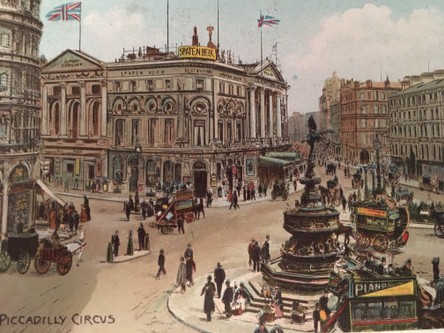 It is certainly the most famous area of London, a famous place worldwide. Not quite so well-known is the fact that the statue at the centre of the square, dedicated to the philanthropist Ashley, count of Shaftesbury, depicts charitable love and not Eros, as instead most are led to believe. The sculptor Alfred Gilbert decided on the use of emblematic representations to represent the great generosity of the noble, who must evidently have been such not only by name, but also in character. This was achieved through the symbolic figure of a god, his wings spread wide, and an arrow just released from his bow. The statue was made of aluminium, a metal which was only just starting to be used for such manner of work. At the base, there was a fountain with statues of children and fish placed at the centre of the water display.
It is certainly the most famous area of London, a famous place worldwide. Not quite so well-known is the fact that the statue at the centre of the square, dedicated to the philanthropist Ashley, count of Shaftesbury, depicts charitable love and not Eros, as instead most are led to believe. The sculptor Alfred Gilbert decided on the use of emblematic representations to represent the great generosity of the noble, who must evidently have been such not only by name, but also in character. This was achieved through the symbolic figure of a god, his wings spread wide, and an arrow just released from his bow. The statue was made of aluminium, a metal which was only just starting to be used for such manner of work. At the base, there was a fountain with statues of children and fish placed at the centre of the water display. Unfortunately, Gilbert’s work was unlucky from the very start. The City Council almost immediately closed off the water, which had been flowing out onto the street. Therefore the sculptor’s idea, according to which the statue was to be seen through a veil of water, fell flat. Moreover, the material he had used had cost him two and a half times as much as the money he had received for the job. Thus, depressed and bankrupt, he moved to Bruges after asking that the fountain be disassembled, sold as spare parts, and the profit given to the poor.
Until halfway through the Nineteenth Century, Piccadilly Circus had been a magnificent square, designed by John Nash as part of his plan for Regent Street.
It could be accessed via four places corresponding to the cardinal points. One could admire Carlton House, the residence of the prince regent, later demolished in 1827. The quadrant at the southern curve of Regent Street was decorated by a row of arches and columns.
The colonnade was demolished in 1848, when Shaftesbury Avenue was built, cut right across the quadrant. Ever since then, the harmony of the square has been ruined.
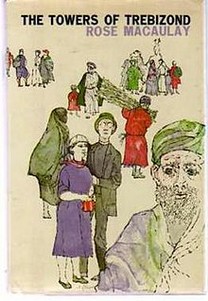 Crazy Traffic – Unfortunately today the streets that cross the square passing next to the fountain are always suffocated by traffic. The situation was already critical in 1956, when Rose Macaulay, in her book The towers of Trebizond, wrote: “we drove from Folkstone in time to enter the slow-paced traffic of Sunday evening. Everyone had come up with the same plan: to leave early in order to avoid the rush hour, but precisely for that reason, it was impossible to avoid. People were on edge, and were tooting their horns, cutting across each other’s paths, and I was behaving no differently. Buses seemed to be passing through traffic lights a good ten seconds after they had turned red, a habit which has always filled me with rage, as it is of the utmost meanness because this way one steals other people’s right to pass through...”
Crazy Traffic – Unfortunately today the streets that cross the square passing next to the fountain are always suffocated by traffic. The situation was already critical in 1956, when Rose Macaulay, in her book The towers of Trebizond, wrote: “we drove from Folkstone in time to enter the slow-paced traffic of Sunday evening. Everyone had come up with the same plan: to leave early in order to avoid the rush hour, but precisely for that reason, it was impossible to avoid. People were on edge, and were tooting their horns, cutting across each other’s paths, and I was behaving no differently. Buses seemed to be passing through traffic lights a good ten seconds after they had turned red, a habit which has always filled me with rage, as it is of the utmost meanness because this way one steals other people’s right to pass through...”WATERSTONES BOOKSHOP
202-206, PICCADILLY
UNDERGROUND: PICCADILLY CIRCUS
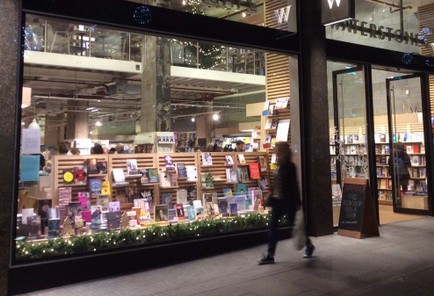 The building where Waterstones has been since 1999 is the work of Joseph Emberton and has a wonderful facade covered in Portland stone. The shop was the first to have a long hollowed pane of glass, something made possible by novel techniques in submerged arc wielding. It is worth the effort of passing it by, just to witness its striking effect. The facade on Jermyn Street was once that of the Museum of Practical Geology.
The building where Waterstones has been since 1999 is the work of Joseph Emberton and has a wonderful facade covered in Portland stone. The shop was the first to have a long hollowed pane of glass, something made possible by novel techniques in submerged arc wielding. It is worth the effort of passing it by, just to witness its striking effect. The facade on Jermyn Street was once that of the Museum of Practical Geology.The vast rooms of the library used to host Simpson’s Department Store. It was a clothes shop for wealthy men, members of the “tweed set”. The customers were important politicians, land owners, and dignitaries, who would often wear the expensive tweed clothes.
There is a strange connection between the Simpson headquarters and the current use of the place. One of the tailor’s shop assistants, who went by the name Jeremy Lloyd, later became a writer and a successful playwright. In one of his more famous works, which later became a television series, going by the title Are you being served?, he used his previous work experience to great effect with an exhilarating outcome.
One of the extraordinary and pleasant things to be done in this bookshop is to choose books, head up to the bar on the fifth floor by taking the old lift with its unique buttons, and tuck into one’s reading in front of a nice cup of tea or coffee. Before leaving, one can stand at the windows, and take in the wonderful view of the London Eye, the Big Ben, and the tower of Westminster Cathedral, which are all enchanting when the sun sets.
ST JAMES CHURCH
197, PICCADILLY
UNDERGROUND: PICCADILLY CIRCUS, GREEN PARK
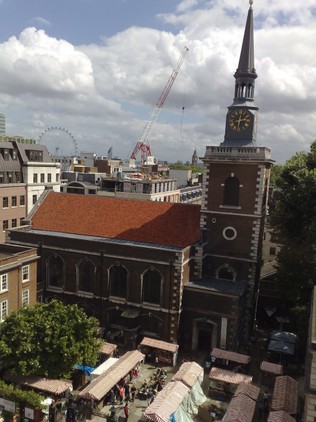 It is the parish of the Royal Academy and hosts artists both alive and dead, seeing as many of them, after having taken part in the religious services here during their life, were also buried here. For example, this was the case for Willem van de Velde, both father and son, marine painters of Dutch origin. Others are the Flemish James Huysmans, also from the Seventeenth Century, an author of portraits, and the Nineteenth Century cartoonist James Gillray. Also James Christie lies here, the owner of the famous auction house.
It is the parish of the Royal Academy and hosts artists both alive and dead, seeing as many of them, after having taken part in the religious services here during their life, were also buried here. For example, this was the case for Willem van de Velde, both father and son, marine painters of Dutch origin. Others are the Flemish James Huysmans, also from the Seventeenth Century, an author of portraits, and the Nineteenth Century cartoonist James Gillray. Also James Christie lies here, the owner of the famous auction house. The original building, which dates back to 1684, was designed by Sir Christopher Wren, but was partially remade after the damage from the Second World War. That of today is in red bricks with decorations in Portland stone. On the inside, the lateral galleries are sustained by square pillars, whereas the barrel vault of the central nave is held up by Corinthian pillars. The monumental baptismal font of refined marble dates back to 1757 and is the work of Grinling Gibbons. The stem which holds it up is the sculpted shape of the tree of knowledge, with wreaths of flowers and fruits, a serpent wrapped around it, and the figures of Adam and Eve on the sides.
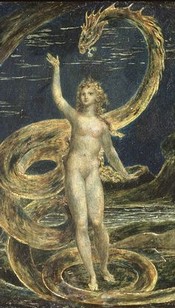 William Blake in an Adamitic costume – William Blake was baptised at this baptismal font and it could be said that the figures of Adam and Eve marked him for life, due to the fact that as an adult he would come here with his wife and would sit with her on a bench in the garden. They would both be naked, and explained the gesture by claiming that they were role-playing Adam and Eve.
William Blake in an Adamitic costume – William Blake was baptised at this baptismal font and it could be said that the figures of Adam and Eve marked him for life, due to the fact that as an adult he would come here with his wife and would sit with her on a bench in the garden. They would both be naked, and explained the gesture by claiming that they were role-playing Adam and Eve. The statues of the angels and cherubs in the act of sounding the trumpets, which decorate the organ built by the great organ manufacturer Renatus Harris in 1685, come from the Catholic chapel of James II in Whitehall. In more recent years, namely between 1902 and 1905, Leopold Stokowski was the choir master in this church, before setting off for New York. The southern nave has been transformed into a chapel and on the wall it bears a Pieta by the painter and lithographer Francis Ernest Jackson. The church cemetery has become a garden in memory of the strength of will of Londoners during the Second World War.
The attractive fence which runs along Piccadilly was designed by Reginald Blomfield. In this church concerts of classical, opera, and folk music are often held, and the timetable is shown on the posters which hang on the outer side of the fence. In the courtyard there are some tables which belong to a café-restaurant. Just next to it, is a market selling small paintings, jewellery, scarves, clothing, and rather unusual hats. Every Tuesday there are stands selling antique items, whereas during the Christmas period, items are sold on the theme of the festivity.
HATCHARDS BOOKSHOP
187, PICCADILLY
UNDERGROUND: PICCADILLY CIRCUS
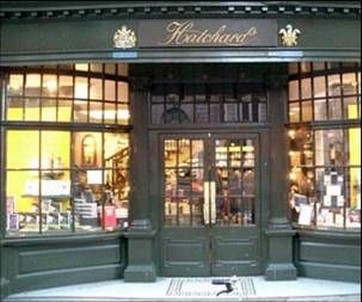 Hatchards Bookshop, which is next to the Fortnum & Mason Emporium and opposite the Royal Academy, is the oldest in the United Kingdom and one of the most pleasing to the eye. Since 1797 its shelves in shiny black wood have contained rich series of bibliographies, books on the subjects and genres of art, narrative, travel, gardening, history, or economy and finance. Amongst its most important clients have been the likes of Queen Charlotte, the Prime Minister Disraeli, General Wellington, the writer Rudyard Kipling, the playwright Oscar Wilde, and the poet George Byron. Today many writers, actors, politicians, and scientists come to the bookshop to present their books and sign autographs on them. Just before Christmas, an evening encounter between writers and readers is organized.
Hatchards Bookshop, which is next to the Fortnum & Mason Emporium and opposite the Royal Academy, is the oldest in the United Kingdom and one of the most pleasing to the eye. Since 1797 its shelves in shiny black wood have contained rich series of bibliographies, books on the subjects and genres of art, narrative, travel, gardening, history, or economy and finance. Amongst its most important clients have been the likes of Queen Charlotte, the Prime Minister Disraeli, General Wellington, the writer Rudyard Kipling, the playwright Oscar Wilde, and the poet George Byron. Today many writers, actors, politicians, and scientists come to the bookshop to present their books and sign autographs on them. Just before Christmas, an evening encounter between writers and readers is organized. FORTNUM & MASON
181, PICCADILLY
UNDERGROUND: PICCADILLY, GREEN PARK
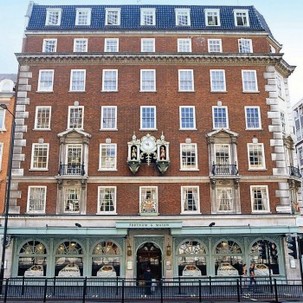 Just above the door at the entrance of the famous emporium, there is an enormous clock, installed in 1964, and its tolls mark the passing of hours accompanied by background music, and the statues of Fortnum and Mason just outside the lateral sentry boxes, where they are portrayed in the act of greeting each other with a slight bow. The bells of the music box chime every quarter of an hour. The emporium has existed since 1707, and is known worldwide for the high quality of its products. In particular, it is worth visiting the splendid Food Hall, where the attentive care with which the array of gastronomy delicacies has been laid out gives one the impression of being at an exhibition.
Just above the door at the entrance of the famous emporium, there is an enormous clock, installed in 1964, and its tolls mark the passing of hours accompanied by background music, and the statues of Fortnum and Mason just outside the lateral sentry boxes, where they are portrayed in the act of greeting each other with a slight bow. The bells of the music box chime every quarter of an hour. The emporium has existed since 1707, and is known worldwide for the high quality of its products. In particular, it is worth visiting the splendid Food Hall, where the attentive care with which the array of gastronomy delicacies has been laid out gives one the impression of being at an exhibition. In the Eighteenth Century, Fortnum & Mason would supply the Royal house with game meat in gelatine, which was very much the fashion at the time. During the Napoleonic wars, the company would send spices, nuts and dried fruit, and preserved food to the posts of British officers all over the world. During the Crimean war, it would send stock cubes of meat extract for broth to Florence Nightingale for the wounded soldiers. In 1851, it created a dish based on egg yolk mixed up with mincemeat, cooked in a casing made of the crumb of bread. In 1886, the company was selling Mr Heinz’s first canned baked beans in tomato sauce. The shop is also famous for the picnic hamper containing Stilton cheese, which is somewhat similar to Gorgonzola, smoked salmon, tea, and for those who pay no heed to expenses, also Champagne. Many purchase the hamper around Christmas time, as a present. Still today, one can have it delivered to one’s doorstep, by means of horse and cart with a coachman dressed in Victorian clothing. The Soda Fountain in its pastel hues, was restored in 1980, and distributes gigantic ice-creams with pieces of fruit , whipped cream, and syrup.
For gourmands – If one wishes to choose something typical to take home, one may opt for a jar of chutney - an Anglo-Indian sauce based on fruit, vegetables, and spices – or else some delicious mango or mustard sauce which literally leaves one breathless.
Between 3 p.m. and 6 p.m. there is a light afternoon meal, with a wide choice of desserts, small rhubarb cakes, vanilla croissants, chocolate éclairs, and small mandarin-flavoured iced cakes. On special occasions such as exhibitions and unusual ceremonies, there are theme cakes, such as chocolate cakes covered with sugar sunflowers for an exhibition on Van Gogh, or confectionary reproductions of some of the Wimbledon tennis tournament symbols, and the list goes on... Some traditional dishes have also been brought back. There are a good five restaurants to be found.
HOTEL RITZ
55, PICCADILLY
UNDERGROUND: GREEN PARK
It was built in 1906 by Mewès and Davis, the same ones who had erected the homonymous French version, and who had made use of Norwegian granite. The building has a colonnade similar to that of rue de Rivoli, and from the window one can take in a lovely view which looks out over Green Park.
Coming here to drink some tea is an experience which is even more unique than Fortnum & Mason.

For gourmands – The ritual involves being greeted at the entrance by two porters who with one hand thrust the doors open, and with the other touch their top hats in a welcoming gesture. After this, a waitress deposits a silver tray on the table with some small triangular sandwiches with a filling of ham or salmon and eggs on the lowest tier, hot bread with cream and strawberry jam on the middle tier, and filled meringues and multicolour mini-cakes on the highest tier. Unfortunately one must book in advance.
BURLINGTON ARCADE
32-33, BURLINGTON ARCADE
UNDERGROUND: PICCADILLY
The arcades with the shops were once the shopping centres of the past. In London there were many: Burlington, Piccadilly, Royal Opera House, Halkin... They are all extremely beautiful, and one can avoid the rain with an excuse to gaze through the windows of shops. Burlington Arcade, which runs from Piccadilly to Burlington Gardens, was opened in 1819. Its construction was ordered by Lord Cavendish following the design of the architect Samuel Ware. Having been the first, it inspired many other European galleries, starting with that of Victor Emanuel II, in Milan. In origin, there were seventy-two shops beneath the arcade, whereas now there are around forty. There are boutiques for clothing, footwear, accessories, art, and antiques, although the specialty for which they are best known is antique silver. The facade facing Piccadilly was added in the early Twentieth Century, and was inspired by Victorian Mannerism. Beneath the glass ceiling, which allows a vast amount of light to pass through, the Beadles patrol in their traditional uniforms and wearing tails and a top hat, enforcing the rules and the code of conduct. The original ones were members of Lord Cavendish’s hussar regiment.

Piccadilly Arcade – It is located between Piccadilly and Jermyn Street, at the level of address number 53, and was opened in 1909. The architect Thrale Jell built it upon the area of the Egyptian Hall. Piccadilly Arcade starts just in front of the latter and has sixteen shops, most of which sell clothing. Here one can find the handmade shirts of the nearby Jermyn Street.
There is also a charming display window with the famous Wedgewood porcelains. At number 17, stands an unusual shop, the Armoury of St James, which sells military medals, of the Orders of Cavalry, hand-painted toy soldiers, military models, nautical antique items, small bronze reproductions of statues, such as that of the Duke of Wellington, for example. On the southern side of Piccadilly, just next to the Church of St James, is the Princes Arcade, which crosses Jermyn Street.

ARLINGTON STREET
UNDERGROUND: GREEN PARK
Horace Walpole was born in this street on 24th September, 1717. Walpole was a writer and a historian – author of the Gothic novel The Castle of Otranto – yet he was also a political man, who ruled for a longer period than any other as Prime Minister. He was the inventor, in 1754, of the term serendipity, which indicates an unexpected fortune, the discovery of things that one was not previously seeking. He drew the term from an ancient Persian fable, whose protagonists were three travelling princes. Serendipity has recently been included in the list of names that are most difficult to translate into other languages. He too had set off for the Grand Tour, and had come to Italy with his friend Thomas Gray. In Florence he had encountered Lady Montagu and had later written about her in an ironic fashion.
At number 16, entering from Park Place, stands the Royal Over-Seas League, a non-profit organization which arranges many activities for members and supports the Commonwealth with social and cultural initiatives, with exhibitions and concerts. It also organizes guided visits to Buckingham Palace and the Clock tower, as well as teatime on the terrace of the Palace of the Parliament.
Cayman Isles – At number 6 in the same street, there is a tourist agency known as the Cayman Tourist Office. If you should ever get the idea of going for a holiday in one of these Caribbean Isles, discovered by Christopher Columbus in 1503, and populated by pirates before falling under English domination, now famous for being a tax haven, here one can get information about deep-sea diving and snorkelling. One of the main attractions is a beach with extremely fine white sand which spreads out over for a good seven miles, near to which there are some turtle and sting ray breeding farms.
THE IMPENITENT BACHELORS OF ALBANY
ALBANY COURT YARD
UNDERGROUND: PICCADILLY CIRCUS
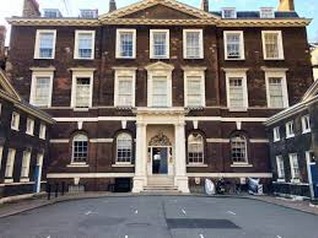 This elegant palace was built in 1770 by William Chambers for Peniston Lamb, viscount of Melbourne and first Prime Minister for Queen Victoria. In 1791 the property of the building passed over to the Duke of York and Albany, who named it. In 1802, the three-storey palace was transformed and divided into roughly seventy apartments, which became extremely famous for being rented only to bachelors. Amongst the unmarried men who lived here, there were many poets and writers, such as Lord Byron, who would complain about the small amount of room at his disposal. During the following years, J.B. Priestley lived here, as well as the photographer Antony Armstrong-Jones, count of Snowdon, when he had not yet married princess Margaret, sister of Queen Elizabeth. Today the restriction regarding the leasing recipients has been lifted, and the apartments are rented also to married couples. The palace is mentioned in various different works of English authors, such as Oscar Wilde and Charles Dickens.
This elegant palace was built in 1770 by William Chambers for Peniston Lamb, viscount of Melbourne and first Prime Minister for Queen Victoria. In 1791 the property of the building passed over to the Duke of York and Albany, who named it. In 1802, the three-storey palace was transformed and divided into roughly seventy apartments, which became extremely famous for being rented only to bachelors. Amongst the unmarried men who lived here, there were many poets and writers, such as Lord Byron, who would complain about the small amount of room at his disposal. During the following years, J.B. Priestley lived here, as well as the photographer Antony Armstrong-Jones, count of Snowdon, when he had not yet married princess Margaret, sister of Queen Elizabeth. Today the restriction regarding the leasing recipients has been lifted, and the apartments are rented also to married couples. The palace is mentioned in various different works of English authors, such as Oscar Wilde and Charles Dickens. ROYAL ACADEMY OF ARTS
BURLINGTON HOUSE
UNDERGROUND: PICCADILLY CIRCUS, GREEN PARK
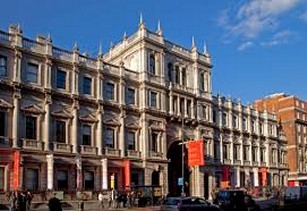 It was founded in 1768 by George III, and Joshua Reynolds was its first president. Above each of the seven windows, there is a niche, separated from the others by Corinthian pillars bearing a statue each, two of which portray Michelangelo and Titian, and are the work of Calder Marshall. One represents Leonardo Da Vinci, and is the work of Edward Stephens, whereas yet another depicts Raphael, and is by Henry Weekes. At the back of the building, we find the great thinkers, such as the philosopher David Hume.
It was founded in 1768 by George III, and Joshua Reynolds was its first president. Above each of the seven windows, there is a niche, separated from the others by Corinthian pillars bearing a statue each, two of which portray Michelangelo and Titian, and are the work of Calder Marshall. One represents Leonardo Da Vinci, and is the work of Edward Stephens, whereas yet another depicts Raphael, and is by Henry Weekes. At the back of the building, we find the great thinkers, such as the philosopher David Hume. 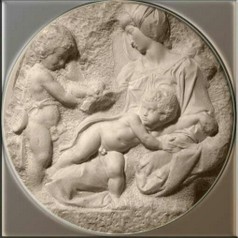 Michelangelo’s Taddei Tondo – The most famous piece of the collection is kept in a different room. It consists of a small bas-relief in Carrara marble, made by Michelangelo and representing the Madonna with Child and Saint John the Baptist. The Taddei was sculpted in 1504-1505. It belonged to a Florentine patron, Tondo Taddei, and in 1823 George Beaumont purchased it from the man’s descendants and left it to the Academy in his will. It is one of the four sculptures by Michelangelo which are located outside of Italy. S. John is portrayed in the act of offering a gold finch to Christ , as a symbol of Passion.
Michelangelo’s Taddei Tondo – The most famous piece of the collection is kept in a different room. It consists of a small bas-relief in Carrara marble, made by Michelangelo and representing the Madonna with Child and Saint John the Baptist. The Taddei was sculpted in 1504-1505. It belonged to a Florentine patron, Tondo Taddei, and in 1823 George Beaumont purchased it from the man’s descendants and left it to the Academy in his will. It is one of the four sculptures by Michelangelo which are located outside of Italy. S. John is portrayed in the act of offering a gold finch to Christ , as a symbol of Passion.Baby Jesus is withdrawing and seeking protection between the arms of his mother.
The Meeting Hall, its ceiling decorated by Sebastiano Ricci’s fresco The meeting of Bacchus and Arianna, was painted by Ware in order to host gala lunches. In recent years, a staircase and a glass lift, designed by Norman Foster, have been installed between the two buildings which are the headquarters of the Academy. They both lead to a vast entrance with windows, beyond which one can see the original facade by leaning out from the parapet.
From this hall, one can access the previous Diploma galleries (which have now been replaced by the brightly lit Sackler Wing, decorated with statues) which were added during the Victorian epoch above the building. The rooms, which have been completely renovated, have ceilings with barrel vaults and host high-profile temporary exhibitions.

SEBASTIANO RICCI AT THE BURLINGTON HOUSE
PICCADILLY
UNDERGROUND: GREEN PARK
The construction of the house began in 1664, an undertaking of the poet and architect John Denman. Later, in 1715, the building was renovated following the Palladian style, with triangular gables and pointed arches on the windows. The flooring of the halls on the ground floor is similar to that of Queen’s House of Greenwich, that of the large halls on the first floor is similar to that of Banqueting House in Whitehall.

William Kent frescoed these walls and ceilings alongside Sebastiano Ricci. The latter, born in 1659, was an artist of great genius and with a remarkable ability of execution, and was one of the first Venetian travelling painters. For Burlington House he also carried out eight canvases with mythological subjects, as well as frescos on the walls of the staircase, with the Triumph of Galatea on one side, and Diana and the nymphs on the other. On the ceiling of the Council Hall, he painted the gods of Mount Olympus. Also Giovanni Antonio Pellegrini, who emigrated to England in 1708, contributed towards the decoration of Burlington House with a number of paintings, although these have been moved to Chiswick House. In 1867 the building was sold to the government and risked being demolished, in order to make room for the university. The stables, the pretty colonnade which connects the street, and the majestic entrance portal were effectively eliminated, but fortunately the building was saved. Today it hosts a series of important societies, starting with the renowned Royal Academy of the Arts, the Geological Society, and the Astronomical Society. Here too, is the Society of Antiquaries, which amongst its masterpieces, owns a diptych dating back to 1616 by John Gipkyn which portrays the old cathedral of St Paul. In the diptych, beyond the tower, one can see the preaching cross, erected on the land just in front of the church, where there is also a pulpit where sermons were held.
A CAT WITH A HAT AT BATES
JERMYN STREET
UNDERGROUND: PICCADILLY CIRCUS
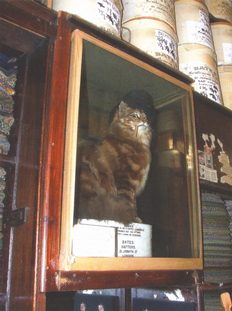 Customers who visit Bates in order to purchase an Ecuador Coffee Planters hat, a Fischer Fedoras, or a Henley Boaters, can try on these hats under the vigilant stare of Binks. Binks is a cat who entered the shop way back in 1921 and who lived there until his death, in 1926. After being stuffed, the cat was placed within a glass display, with a hat on its head and a cigar in its mouth. It is surrounded by columns of tweed hats, and piles of hat boxes bearing plaques which indicate their contents. There is also a plaque on the animal’s glass crate, warning those who stare at the beast with curiosity, and inviting them to leave a small donation.
Customers who visit Bates in order to purchase an Ecuador Coffee Planters hat, a Fischer Fedoras, or a Henley Boaters, can try on these hats under the vigilant stare of Binks. Binks is a cat who entered the shop way back in 1921 and who lived there until his death, in 1926. After being stuffed, the cat was placed within a glass display, with a hat on its head and a cigar in its mouth. It is surrounded by columns of tweed hats, and piles of hat boxes bearing plaques which indicate their contents. There is also a plaque on the animal’s glass crate, warning those who stare at the beast with curiosity, and inviting them to leave a small donation. Jermyn Street, at the centre of Piccadilly, bears the name of the first count of St Albans. That it is a street of great elegance is apparent also due to the statue of Beau Brummell, who is portrayed in a pose which reveals how conscious he was of being the incarnation of refinement and good taste. Even if one does not wish to buy anything at all, nor have suits or shirts tailor-made for oneself, it is pleasant to come here for a walk to take a look at the old shop windows selling tailor-made shoes and boots, perfumes, beard brushes, cigars, and so on…
There is even a Beretta shop, with competition pistols, rifles, and hunting wear. There are many attractions, events, forms of entertainment, and restaurants, amongst which a Russian one, called Abracadabra.
APSLEY HOUSE, THE NUMBER ONE
HYDE PARK CORNER
UNDERGROUND: HYDE PARK CORNER (3RD EXIT)
It is one of the finest houses in the capital. It is known as the Number One, due to the fact that it was once the first building which one would come across when arriving from the countryside, after the border. It was designed by Robert Adam in 1771 for the baron Apsley. The Duke of Wellington purchased it in 1817 and applied some significant changes to it. He enhanced it with elegant halls for his splendid receptions, the most famous of which was the Waterloo Banquet, to which he invited the officers who had taken part in the battle, and who would eat in the long Waterloo Gallery.
The duke had had it covered up, much to the horror of his wife, who found that the colour did not much fit the paintings which were hanging there. The set of dishes used for that banquet was the same one as that used by Napoleon for his Josephine, renamed Egyptian Sèvres.

In 1947, the house and all that it contained were donated to the nation. Its collection of Spanish paintings had a bizarre history. When Joseph Bonaparte, nominated by his brother as King of Spain, was captured by the English, he had somewhere around two hundred of them with him. The Duke of Wellington seized them, had them restored, and then offered them to the new king who had been restored to the throne. However the monarch of Spain left them to him. Amongst the paintings of greatest value are those of Velàsquez, others by Bruegel, Vermeer, Rubens, Murillo, Correggio, and two from the school of Caravaggio.
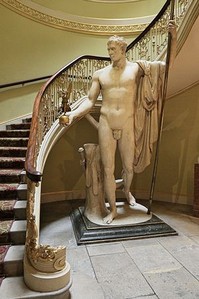 The Bony nude – At the base of the staircase, there is a gigantic nude statue known as Bony. It is none other than Napoleon, going by his nickname as given to him by the English. The statue was sculpted in Canova in 1803 and took six years to be finished. It was donated by Luis XVIII to the English government, after Waterloo. Napoleon is portrayed as a pacifying god, dressed in a Roman chlamys resting on his left shoulder. The emperor had come to dislike this statue, though he himself had commissioned it. It seemed to him that it was somehow a bad omen, and he had the feeling that the figure of winged victory, which rests its foot on Earth’s globe which he holds in his hand, might be on the verge of flying off.
The Bony nude – At the base of the staircase, there is a gigantic nude statue known as Bony. It is none other than Napoleon, going by his nickname as given to him by the English. The statue was sculpted in Canova in 1803 and took six years to be finished. It was donated by Luis XVIII to the English government, after Waterloo. Napoleon is portrayed as a pacifying god, dressed in a Roman chlamys resting on his left shoulder. The emperor had come to dislike this statue, though he himself had commissioned it. It seemed to him that it was somehow a bad omen, and he had the feeling that the figure of winged victory, which rests its foot on Earth’s globe which he holds in his hand, might be on the verge of flying off. PORTER’S REST
PICCADILLY
UNDERGROUND: HYDE PARK CORNER
Just before the pedestrian underpass in Piccadilly, in the spot where there is a junction with Hyde Park Corner, stands the last exemplary specimen of a supporting structure which was once present in many points of the city. These supports were usually found along the streets with numerous hotels. They were used by porters, who could rest their load on them without actually removing it from their shoulders, but by standing just next to them. In this manner, it was not even necessary for them to remove their porter’s knot, a small cushion that they would use to protect their shoulders. The job of carrying loads or baggage in stations or harbours has almost disappeared, and so have the horses and mules transporting goods on their carts. These supports would have also disappeared, if not for an MP who opposed disassembling them, seeing as they represented, in his words, “the keepsake of a vanished world, a testimony of the history of the city”. Today this surviving object is used by travellers with their rucksacks for laying down their weight for a moment, and by people drinking beverages as a place to rest their glass or coffee cup.

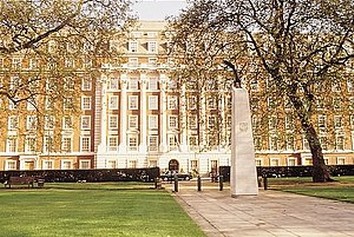 The name of this aristocratic neighbourhood, made up of elegant houses dating back to the Nineteenth Century in the Victorian style, derives from that of a market place. In fact in this area, from 1686 to 1764, a cow market was regularly held.
The name of this aristocratic neighbourhood, made up of elegant houses dating back to the Nineteenth Century in the Victorian style, derives from that of a market place. In fact in this area, from 1686 to 1764, a cow market was regularly held. The area of the Forum Boarium corresponds to that of Shepherd Market, the name of which is not truly referred to a shepherd, but rather to its builder, Edward Shepherd, who along with his brother was responsible for many of the streets in the neighbourhood.
Shepherd had purchased the lands from Nathaniel Curzon and had created the market, and the streets which lead into it, Shepherd Mews and Shepherd Street, still bear his name. In the Conduit Fields there is a water source known as Shepherd’s Well, which once fed into a stone duct that transported its extremely pure water. Until the end of the Nineteenth Century it was an important reserve for the inhabitants of Mayfair.
In the past, the houses in Mayfair were inhabited by aristocrats and land owners, and today many of them host embassies, airline companies, and real estate agencies. There are many beautiful shops in the area, and it is great fun to do some window shopping here, especially as the products on sale are anything but cheap. There are also restaurants and luxury hotels, such as Claridge’s.
Walking through Mayfair – A pleasant walk could include Brook Street, Grosvenor Square, Hanover Square, and Hanover Street. The height of the buildings which stand along these streets is uniform, and the modern facades even manage to fit in rather well amid the older ones. The reticule of small streets west of New Bond Street has survived without suffering many alterations in time, and is definitely worth seeing.
BOND STREET
UNDERGROUND: BOND STREET
This is the street of elegant shopping, the most exclusive in West End, at the extreme opposite of Oxford Street. It bears the name of Thomas Bond, a real estate operator who purchased the elegant Clarendon House, demolished it, and built a series of apartments over it. The street is also known for the art boutiques and antique sellers, which are grouped around the auction house Sotheby’s. The highest concentration of art galleries is in Old Bond Street. The oldest of them is that of Paul Colnaghi, which is at number 15 and was opened way back in 1783. Within its halls, adorned with red silks, are the paintings of the Old Masters, which are on sale and date back to 1800. At number 43 stands the Agnew’s gallery, which was founded in 1817, and where paintings by British painters are sold.

On the West side of Bond Street, at number 167, are Asprey’s shop windows. The shop was opened in 1781 and at the time it manufactured travel utilities as it still does today. In time, other luxury products have been added, such as jewellery and prized books. The street has a bizarre numbering, which rotates, as the numbers are in increasing order on the East side up to Burlington Gardens, and in decreasing order on the other side.

When it reaches Tiffany, the street becomes New Bond Street and at number 153, stands the Time-Life building, designed by Michael Rosenauer. On its facade, there is a pretty frieze sculpted by Henry Moore, which unfortunately is placed so high up that it is not all that visible. It is an abstract sculpture, formed by four pieces. When Moore saw that they were placing it at such a height, he offered to buy it back, but it was not sold back to him.
Bond Street is a literary place par excellence, and it is mentioned in Pride and Prejudice by Jane Austen and also in Mrs Dalloway by Virginia Woolf. Queen Victoria would regularly visit a shop underwear in order to purchase her knickers.
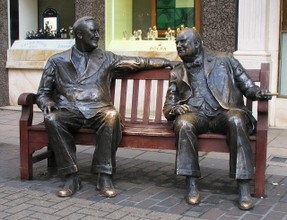 Churchill and Roosevelt - In the street there stands an unusual group of statues, created by the sculptor Lawrence Holofcener, where Winston Churchill and Franklin Delano Roosevelt are portrayed sitting on a bench with a very relaxed demeanour, immersed in their conversation. The statue is called Allies and is a very human depiction of the two statesmen. It was discovered by Princess Margaret and has now become a tourist attraction.
Churchill and Roosevelt - In the street there stands an unusual group of statues, created by the sculptor Lawrence Holofcener, where Winston Churchill and Franklin Delano Roosevelt are portrayed sitting on a bench with a very relaxed demeanour, immersed in their conversation. The statue is called Allies and is a very human depiction of the two statesmen. It was discovered by Princess Margaret and has now become a tourist attraction. SOTHEBY’S PAINTINGS
34-35 NEW BOND STREET
UNDERGROUND: BOND STREET
Sotheby’s auction house was founded in 1744 by Samuel Baker and for many decades it took care of the sales of rare books. Only in 1913 did it also start selling works of art, along with nicely presented catalogues. Today the society belongs to the American Taubman, and has a remarkable amount of dealings and a branch in Manhattan, as well as internet services, such as a wish-list for customers.
It is interesting to visit it so that one may observe the items on sale, as well as the faces and expressions of the buyers. 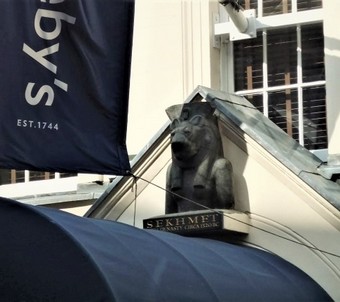
Here one can see the sale of items such as a self-portrait of Van Dyck, a Portrait of a young lady by P.Rubens, or the enormous painting by the eighteenth-century painter Samuel Scott going by the title Ships anchored at the Thames estuary, near Wapping, which portrays the watercraft of a time gone by.
The Egyptian Lioness - Above the entrance, there is a very ancient bas-relief in black basalt, which is a representation of the goddess Sekhmet, considered the muse of good fortune for the household. The statue, which dates back to at least three thousand years ago, was sold in 1880, but the buyer never came to collect it.
THE CHINTZ OF COLEFAX & FOWLER
39 BROOK STREET
UNDERGROUND: BOND STREET
Colefax & Fowler is a shop where chintz is sold, the typical English fabric which is made to look shiny by a special type of finishing. It is an article of internal decoration which inspires very extreme sentiments. In fact, people tend to either hate it or love it. It comes from India, in particular Calcutta, known for its fabrics (in Hindu, the word means “varied”), where it was a calico of vivid colours. It was later produced in Europe for bed covering and sofas, with original designs, especially flower-themed ones. Today, some of the best internal designers leave their own mark in terms of personal style with an eye to tradition, and dedicate a great deal of attention to details, and to matching the chintz to carpets and tapestries, which are supposed to look harmonious alongside each other.

FROM HÄNDEL TO HENDRIX
25, BROOK STREET
UNDERGROUND: BOND STREET
Between 1723 and 1759, the German composer Georg Friedrich Händel lived in the three-storey house with a dark facade which is located at number 25, Brook Street, after a period during which he lived in Italy. Here, he composed the Oratorios, the Concerti Grossi, the Operas, and also his Water Music, which was executed for the first time on 17th July 1717.
It was King George I who asked him to compose a concert to be performed on the Thames, which was then carried out by fifty musicians perched on a barge in proximity of the Royal barge. The performance included only wind instruments. There were flutes, oboes, bassoons, horns, and trumpets, which are able to produce enough sound to be heard out in the open. The harpsichord had to be left out due to it not fitting on the barge. The king listened to the performance in the company of a few close friends, amongst which the Duchess of Bolton, the Duchess of Newcastle, the Countess of Godolphin, and George Douglas-Hamilton, Count of Orkney. It is said that the king enjoyed the melody so much, that he ordered the musicians, who were exhausted, to repeat the performance three whole times.

Today this masterpiece is often accompanied by the Music for the Royal Fireworks, also written for outdoor performances. A part of the score has also been adapted for smaller orchestras, and it includes the strings, which are not suitable for outdoor playing because their sound does not carry far or loud enough.
Händel’s house has been restored to make it appear as it was in his day and age. It was a typical building from the Eighteenth Century, in the spartan style of the Georgian period.
Händel was its first resident, and lived there for nearly forty years. He also died there, after a life of merrymaking, on the night of 14th April, 1759. He asked his assistant to send the guests away, because he was “done with the world”. Händel was bulimic, and therefore had the habit of gorging himself and downing a lot of alcohol. This had given him gout, blindness, and paralysis and aphasia attacks. In the museum there are collections of memorabilia, including the Byrne collection, purchased in 1998. Musical events, conferences, and children’s events are held here. Within its chambers, shows are performed with Baroque music and recitals, especially in the evening, when the museum is closed.
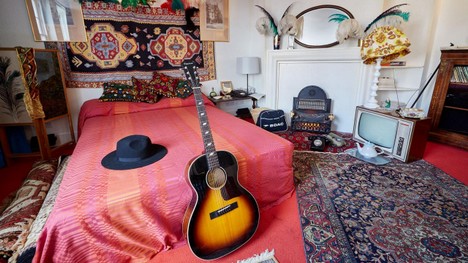
Hendrix’s room – The museum also incorporates the first storey of the next-door house, where in 1968-1969, the rock guitar musician Jimi Hendrix lived. However, unfortunately this part of the museum is only open from time to time, about twice a year, via booking. On the facades of both houses, there are the so-called blue plaques, which bear the names of their occupants.
There is a shop selling musical items on the ground floor.
Avery Row is a small pedestrian street which cuts across Brook Street diagonally. It is very pleasant to go for a stroll here and gaze into the windows of the old shops which look out onto the street.
HANOVER SQUARE
UNDERGROUND: OXFORD CIRCUS
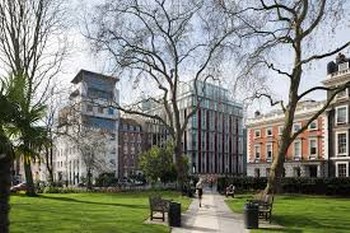 The square was created at the beginning of the XVIII Century and is bordered by residencies for aristocrats. Today, very few houses remain which date back to that period, especially in the south-western corner. A few other eighteenth-century houses can be found on St George Street, a street which has a bizarre funnel shape and which leads onto the square. It is not known why the street was built in such a way, however the view from the square is magnificent.
The square was created at the beginning of the XVIII Century and is bordered by residencies for aristocrats. Today, very few houses remain which date back to that period, especially in the south-western corner. A few other eighteenth-century houses can be found on St George Street, a street which has a bizarre funnel shape and which leads onto the square. It is not known why the street was built in such a way, however the view from the square is magnificent. Albeit bearing a certain general uniformity, many buildings have been built in different periods and styles. Part of the square has been converted into a lawn. On the southern side there is a statue of William Pitt the Younger, the English statesman who introduced important reforms in administration and finance. Pitt was a pragmatic man, who wanted administration to be honest and efficient. Furthermore, like his father before him, he prepared England for the war against Napoleon’s France .
CHURCH OF ST GEORGE
HANOVER SQUARE
UNDERGROUND: OXFORD CIRCUS
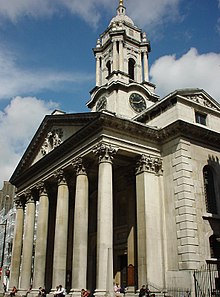 This eighteenth-century church was designed by John James in 1721-25. Today it is very well-known for the weddings of the rich and famous, a tradition which began a long time ago, with the Duke of Sussex, in 1793. On 24th March, 1814, the poet Percy Bysshe Shelley married Harriet Westbrook, only to abandon her four months later, to run off with Mary Godwin. The tradition went on with Benjamin Disraeli, who was later to become prime minister, and who married Mary Ann Lewis, a very rich woman who was ten years his elder. George Eliot, the pseudonym of Mary Ann Evans, and Theodore Roosevelt, to name but a few, also married in this church. It is mentioned in many novels precisely with regard to its reputation for being the church where the rich and famous get married. The central nave has a barrel vault, and the galleries on the sides are supported by square pillars which become circular towards the upper extremity, and end with Corinthian capitals. The Last Supper is depicted on the reredos, painted by William Kent, and is surrounded by a number of panels with sculpted fruit and flowers.
This eighteenth-century church was designed by John James in 1721-25. Today it is very well-known for the weddings of the rich and famous, a tradition which began a long time ago, with the Duke of Sussex, in 1793. On 24th March, 1814, the poet Percy Bysshe Shelley married Harriet Westbrook, only to abandon her four months later, to run off with Mary Godwin. The tradition went on with Benjamin Disraeli, who was later to become prime minister, and who married Mary Ann Lewis, a very rich woman who was ten years his elder. George Eliot, the pseudonym of Mary Ann Evans, and Theodore Roosevelt, to name but a few, also married in this church. It is mentioned in many novels precisely with regard to its reputation for being the church where the rich and famous get married. The central nave has a barrel vault, and the galleries on the sides are supported by square pillars which become circular towards the upper extremity, and end with Corinthian capitals. The Last Supper is depicted on the reredos, painted by William Kent, and is surrounded by a number of panels with sculpted fruit and flowers.On the outside, the great hexagonal porch is formed by six Corinthian columns and has a wonderful panelled ceiling. Beneath it are the statues of two iron dogs, created perhaps by Landseer. They were brought here in 1940 from a shop in Conduit Street, which had been bombarded, and then placed on the sides. The animals are staring dreamily as if awaiting something or someone. There are some obelisks here which were used as support for streetlamps.
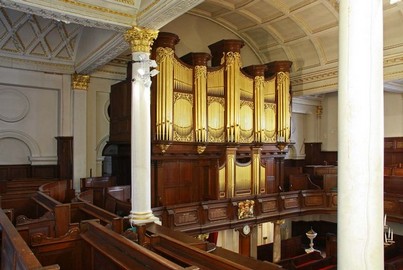 Händel’s Organ – One of the best things about the church is its organ, which is contained in a huge chassis, golden and decorated with five ribbed pillars, built by Gerard Smith in 1725 and remade in 1972. Georg Friedrich Händel, who lived in the nearby Brook Street, was a parishioner of this church and came regularly to services and also to play. Today recitals are held here (usually on Thursday evenings) and between February and April, there is a festival in Händel’s memory. The choir is made up by professionals.
Händel’s Organ – One of the best things about the church is its organ, which is contained in a huge chassis, golden and decorated with five ribbed pillars, built by Gerard Smith in 1725 and remade in 1972. Georg Friedrich Händel, who lived in the nearby Brook Street, was a parishioner of this church and came regularly to services and also to play. Today recitals are held here (usually on Thursday evenings) and between February and April, there is a festival in Händel’s memory. The choir is made up by professionals. CONDUIT STREET
UNDERGROUND: OXFORD CIRCUS
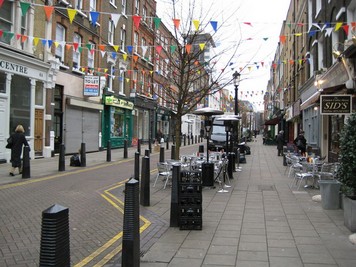 The street crosses what was once Conduit Mead, a field where a wooden conduit used to pass through: this is the reason for the name; in the Middle Ages it brought water from Tyburn to London city. At the time, the owners of the land where the conduits passed would ask for a very high toll in return for conceding the right to pass through. The resupplying of water is mentioned for the first time in a document from 1236. The source used to be in the area where Stratford Place is today. There were also other sources in the area, all equipped with gates to protect them. The presence of water sources has remained, for example, in the names Conduit Mews, whose tubes started from Ox Close, and Conduit Place.
The street crosses what was once Conduit Mead, a field where a wooden conduit used to pass through: this is the reason for the name; in the Middle Ages it brought water from Tyburn to London city. At the time, the owners of the land where the conduits passed would ask for a very high toll in return for conceding the right to pass through. The resupplying of water is mentioned for the first time in a document from 1236. The source used to be in the area where Stratford Place is today. There were also other sources in the area, all equipped with gates to protect them. The presence of water sources has remained, for example, in the names Conduit Mews, whose tubes started from Ox Close, and Conduit Place. THE QUEEN’S STATIONERY SHOP
40, NEW BOND STREET
UNDERGROUND: OXFORD CIRCUS
Smithson is the Queen’s stationery preference, and this just goes to show the high quality level of the shop, as well as implying very steep prices. Here, marvellous boxes of many shapes and colours can be found, as well as refined paper for writing letters, elegant fountain pens, some diaries for adolescents, but also many items in leather, leather paper, bound diaries, bags, coin purses, pouches for spectacles, key rings, and the list goes on… It is pleasant even just to take a look at the shop window and see the prized items on sale (one of the cheapest is a sleek gold pen) and visit the small museum, where diaries from the beginning of the Twentieth Century are sold, along with some old stamps, stationery used by an Indian maharajah, books of condolences used for John Kennedy and Grace of Monaco, some old tickets and Christmas postcards and telegrams from the time of war.

SAVILE ROW, THE TAILORS’ STREET
UNDERGROUND: OXFORD CIRCUS
Savile Row is the famous street of tailors who create clothing to suit one’s needs. It was built in 1732 on the land belonging to the third count of Burlington, whose wife was Dorothy Savile. The English term which indicates a custom-made item is bespoke. It seems that this expression was born in this very place, when the fabric of clothing was said to “be spoken for”. The street is nicknamed “the golden mile of tailors” and through the years Napoleon III, Lord Nelson, Winston Churchill, and Prince Charles all came here. The traditional style has been gradually modernized, but the work continues to be totally crafted by hand. The competition of the industry has made things more difficult, yet as long as there are people willing to come from every corner of the world to have an item of clothing tailored for them, work will go on.

The shops of the tailors are on the ground floor of the eighteenth-century houses which have survived on the southern side of the street. On the upper floors, there are galleries, such as that of Matthew Brown and that of Laurent Delaye, both at number 11. At number 1, Savile Row, stands the headquarters of the Royal Geographical Society. Here, the burial chamber of Dr. Livingstone has been set up, before later moving it to Westminster Abbey for burial.
THE PALACE BY LEONI AND BONOMI
UNDERGROUND: GREEN PARK
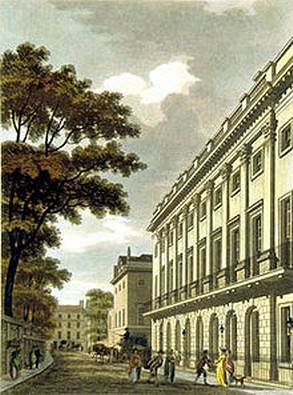 The core of the current building at number 7, Burlington Gardens is formed by the skeleton of a house built in 1723, designed by Giacomo Leoni for the count of Queensbury and inspired by Palladio. In the XVII and XVIII Century, Andrea Palladio’s architecture was a source of emulation and appropriation for architects, who have built a number of buildings which are now perceived as English. Palladio was the model for buildings of different types with different uses, and Leoni too drew inspiration from him. From reading his notes and observing his sketches, it is clear how the work of an architect must have been frustrating, already at the time as it is still today, due to the fact that, in the end, a great deal depended on the desires and whims of the client, ill-chosen and improper as their requests might be.
The core of the current building at number 7, Burlington Gardens is formed by the skeleton of a house built in 1723, designed by Giacomo Leoni for the count of Queensbury and inspired by Palladio. In the XVII and XVIII Century, Andrea Palladio’s architecture was a source of emulation and appropriation for architects, who have built a number of buildings which are now perceived as English. Palladio was the model for buildings of different types with different uses, and Leoni too drew inspiration from him. From reading his notes and observing his sketches, it is clear how the work of an architect must have been frustrating, already at the time as it is still today, due to the fact that, in the end, a great deal depended on the desires and whims of the client, ill-chosen and improper as their requests might be.Following Leoni’s design, the facade was intended to be quite elaborate, however his project was not well received. It was Joseph Bonomi who many years later followed what had been the frustrated intentions of Leoni, and fulfilled it for the Count of Uxbridge. When the Bank of England bought the building, in 1876, it modified the indoor area, in order to make it suitable for housing spacious offices. Only the western part of the house has remained intact, including the main stairway, the antechambers to the North and South, part of the sitting room, and the first floor. Today the building belongs to the Bank of Scotland.
THE ROYAL INSTITUTION-SCIENCE LIVES HERE
21, ALBEMARLE STREET
UNDERGROUND: BOND STREET
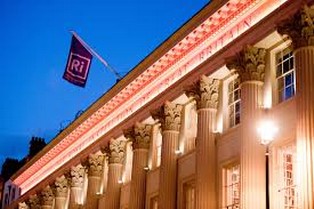 The building’s facade, which is the headquarters of the Royal Institution has conserved the imposing classical colonnade, although the construction has been expanded and modified throughout the centuries. The institute was founded in 1799 by a few famous scientists, amongst which Cavendish and Wilberforce, in order to promote science, spread knowledge, and provide support to new inventions with the aim of applying science more and more to the needs of everyday life.
The building’s facade, which is the headquarters of the Royal Institution has conserved the imposing classical colonnade, although the construction has been expanded and modified throughout the centuries. The institute was founded in 1799 by a few famous scientists, amongst which Cavendish and Wilberforce, in order to promote science, spread knowledge, and provide support to new inventions with the aim of applying science more and more to the needs of everyday life. It is precisely because of the traffic and crowding created by these conferences that the street has become one-way, and was the first ever in the capital for which such a choice was made.
The basement floor hosts Michael Faraday’s laboratory, which has been turned into a museum (see below), with all the equipment used by him. In these rooms, the scientist started the tradition of the Christmas Conferences, which still take place today in the Faraday Lecture Theatre and are broadcast on television.
In 1864, in this very street, Thomas Huxley founded the X Club. Its members would gather at St George’s Hotel and supported the ideas of Charles Darwin.FARADAY’S MUSEUM
21, ALBEMARLE STREET
UNDERGROUND: GREEN PARK
In 1973 the Royal Institution opened a museum within its quarters, dedicated to the scientist Michael Faraday, a chemist and physicist, a researcher of the magnetic field, of which he laid out the foundations for subsequent studies. As a chemist, Faraday had discovered benzene. Yet he had never received an appropriate education, and perhaps because of this he remained a great experimenter, a pioneer in the uses of electricity.

The great building is open to the public during normal office hours and also includes the reconstruction of one of Faraday’s labs. A second room contains many tools of historical value, which are all in some way connected to him. One of these is the first electric engine, which was a trampoline for the development of the transport industry, the first stage for the induction engine, at the base of electric power supply, and the first example of benzene ever to be isolated, which was at the core of the chemical industry.
Faraday was extremely religious. He belonged to the church of Sandemanian, a Christian sect founded in 1730, which required a complete and absolute faith and dedication. His biographers have written that “a strong sense of unity with God and nature pervaded his life and his work”. Evidently his life was not quite so imbued by the beauty of the Italian countryside. In his travel journal, during his time in Italy, he had written off the strip of coast between Genoa and Lerici as unremarkable, whereas it is one of the most beautiful in the world. Too many hours passed in his underground laboratory had evidently robbed him of his sense of admiration for beauty.
ALBEMARLE CLUB
13, ALBEMARLE STREET
UNDERGROUND: GREEN PARK
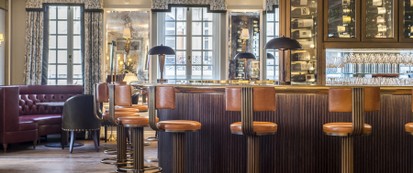 The Albemarle Club was founded in 1874 in order to welcome both men and women and because of this was considered more open and bohemian compared to other more traditional clubs. Albemarle is connected to Oscar Wilde due to the scandals which derived from it. It was in fact here that in 1895 the writer received the card belonging to the Marquise of Queensberry, which bore the words (including a spelling mistake): “For Oscar Wilde, posing as a somdomite”. The marquise was the father of Oscar Wilde’s lover, Alfred Douglas. The writer had reported him, however this had unfortunately been his ruin. The club, whose name had been mentioned a number of times at the trial, lost its reputation and was forced to close due to the fact that the customers no longer frequented it.
The Albemarle Club was founded in 1874 in order to welcome both men and women and because of this was considered more open and bohemian compared to other more traditional clubs. Albemarle is connected to Oscar Wilde due to the scandals which derived from it. It was in fact here that in 1895 the writer received the card belonging to the Marquise of Queensberry, which bore the words (including a spelling mistake): “For Oscar Wilde, posing as a somdomite”. The marquise was the father of Oscar Wilde’s lover, Alfred Douglas. The writer had reported him, however this had unfortunately been his ruin. The club, whose name had been mentioned a number of times at the trial, lost its reputation and was forced to close due to the fact that the customers no longer frequented it. In Albemarle Street one can find the seventeenth-century Clarendon House, a splendid residence purchased by a real estate agency with the sole purpose of demolishing it to build it up with apartments, following the development and growth demands of the metropolis.
MARLBOROUGH FINE ART
SCANDIA HOUSE, 6 ALBEMARLE STREET
UNDERGROUND: GREEN PARK
The Marlborough gallery was founded in 1946 by Frank Lloyd and is one of the most important at an international level, with six to eight exhibitions every year. Edgar Degas’ bronzes, the paintings by Monet, Pissarro, Renoir, and Van Gogh have all passed through it since after the war, along with many others. In the Sixties, the gallery hosted a number of German artists, as well as Kandinsky and the Bauhaus painters. Later on, it hosted the works of Francis Bacon, Henry Moore, Pollock, Egon Schiele, Lucian Freud, and Magritte. Often the artists on exhibition have then been invited to the events in museums and their works have been bought by galleries.

The graphic arts section, specialized in Modern Master and Contemporary Prints, was born forty years ago in order to encourage artists to produce original prints. The gallery is amongst the most important for the sale of etchings, a point of reference for famous artists, but also for young people, amongst which for example Daniela Gullotta from Bologna, who takes photographs of abandoned buildings, “architectural relics” renamed Forgotten Spaces, which she then elaborates and transforms. Marlborough was also the first gallery to propose Chinese artists.
Nearby there are other galleries: the Grosvenor at number 37, the John Martin at 38, Belgravia at 45, the homonymous Albemarle at 49, and the Faggionato Fine Arts, also at number 49 on the first floor.MEDICI GALLERY
5 CORK STREET
UNDERGROUND: GREEN PARK
The Medici Gallery was opened in 1908 by two English partners with the intent of bringing art to the larger public. The paintings, the choice of which would take place depending on their artistic value and the sentiments that they evoked in the beholder, were sold at the lowest possible price. The reason for the name lies in the fact that the Florentine family, which had made so much effort to encourage art during the Renaissance, was a good source of inspiration for taking on a similar task. Furthermore, their trademark logo, until a short while ago, featured the face of Lorenzo the Magnificent.
At first, this was a sort of cooperative company, whose members had the right to a certain number of print copies. For over a century reproductions of works of art with splendid colours were sold here. Some illustrations continue to be published after over seventy years, along with birthday postcards, paper for letters, and calendars with the images of works of art, which are sold in shops such as Paperchase. Amongst the productions of the Medici Gallery are illustrated books for children.

Until halfway through the Nineteenth Century, there were snuffers for torches affixed to the gate, which have since then been replaced by small sculptures of sitting lions.
BERKELEY SQUARE
UNDERGROUND: BOND STREET
The square was created halfway through the Eighteenth Century by the architect William Kent. It bears the name of the family of aristocrats originally from Gloucestershire, who had their family residence here in the city. It is a pretty square with many trees, which the houses of well-off people look out onto. Its sycamores were planted in 1789 and are amongst the oldest in the capital. They are still standing, whereas many of the ancient houses, such as that of Walpole, have been demolished. In the south-western corner of the square, at Fitzmaurice Place, Lansdowne House still stands, designed in 1768 by Robert Adam for the marquise from whom it gets its name, and until 1930 it hosted the homonymous club. When the latter was closed, the living room and the dining room were disassembled and reassembled in the United States.

Amid the square’s centuries-old sycamores, there is a small building with a Chinese roof. Behind it is a pump which sucks up the water from the nearby fountain next to the grating. The fountain has a small monument, the statue of a nymph holding a jug, carried out in 1858 by Alexander Munro, a sculptor who was a follower of the Pre-Raphaelite principles, and whose most famous work is the Paolo e Francesca, portrayed with a kind, languid expression. Immediately after the Berkeley Square statue, he sculpted those of as many as seventeen scientists for the Oxford Museum of Natural History.
The house at number 50 of the square, where the Maggs Bros. bookshop is located, is haunted by ghosts. Or at least it was in the fourth episode of the paranormal investigator Ben Jordan, going by the title Horror at Number 50. The readers of P.G. Wodehouse will remember that Bertie Wooster lived in an apartment which looked out over this square with the butler Jeeves. Nearby, at 12, St George Street is the Drones Club, frequented also by cinema celebrities, such as John Malkovich and Jack Nicholson.
Berkeley Castle – The castle, which stands on Mount Row, was built at the beginning of the Twentieth Century by the artist Frederick Etchells, who was passionate about Medieval architecture. The windows have coloured panes, the chimneys are in stone, and the moulding of the doors is decorated with bas-reliefs of trees and birds. There are hand-written documents by Einstein, Darwin, Wilde, Hemingway, and Freud, an ancestor of the owner, who put it up for sale. The Gothic portal can be seen through an electric blind from a small street between Berkeley Square and Grosvenor Square.
GUNTER’S TEA SHOP
50, BERKELEY SQUARE
UNDERGROUND: BOND STREET
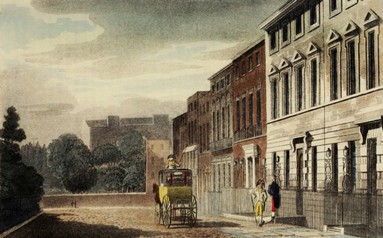 The shop was opened in 1757 by an Italian, Domenico Negri, under a different name and activity. At the time it sold food products and was called Pot and Pine Apple. It also sold sweets following the old English, French, and Italian recipes. In 1797, Negri’s partner, James Gunter, became the sole owner. In the Nineteenth Century, it was transformed into a famous ice cream shop, with a great number of customers who would visit it to consume their ice cream under the shade of the sycamores, forcing the waiters to cross the street hundreds of times a day to serve them. One may also have a light snack and a drink of one’s choice.
The shop was opened in 1757 by an Italian, Domenico Negri, under a different name and activity. At the time it sold food products and was called Pot and Pine Apple. It also sold sweets following the old English, French, and Italian recipes. In 1797, Negri’s partner, James Gunter, became the sole owner. In the Nineteenth Century, it was transformed into a famous ice cream shop, with a great number of customers who would visit it to consume their ice cream under the shade of the sycamores, forcing the waiters to cross the street hundreds of times a day to serve them. One may also have a light snack and a drink of one’s choice.GROSVENOR SQUARE
UNDERGROUND: BOND STREET
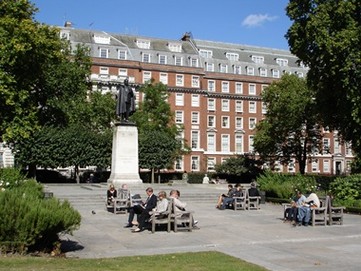 The street that leads into Grosvenor Square through Carlos Place and Mount Street is flanked by unusual shops and two houses with red bricks and ornamental tiles.
The street that leads into Grosvenor Square through Carlos Place and Mount Street is flanked by unusual shops and two houses with red bricks and ornamental tiles.The gracious tree-lined square once represented the centre of the property belonging to the dukes of Westminster, whose nickname was Grosvenor. Until the Second World War, this was one of the prettiest areas in the capital, with buildings built in different styles, which had stables at the back of them. The buildings were demolished to make place for apartments and blocks of flats, able to account for a more efficient use of the space. Some buildings, such as that at number 44, have a historical value because it was at that address that on 21st June 1815, the war council had received the dispatch of Wellington with the news of his victory at Waterloo.
Along the walls of the stairway there is a trompe l’oeil with groups of elegant-looking people leaning out over a balustrade. It has been moved to the Victoria & Albert Museum and placed along the stairs which lead from the rooms where Raphael’s preparatory sketches for the Sistine Chapel are to be found, to the British Galleries.The western side of Grosvenor Square is taken up by the American Embassy, with its entrance at number 24. All around the building there are passage restrictions for security reasons. Also the street which passes in front of it is closed off. The building, namely Chancery Building, is modern and dates back to 1960, and was designed by Eero Saarinen. Its construction brought about some controversy, because its style, with dozens of framed windows, does not fit the Georgian style of the other buildings. The American presence on the square, however, is not recent. As early as 1785, President John Adams had established the quarters for the first United States mission there. These are the final years during which the embassy is to remain there, as the Congress is now deciding where the new headquarters will be moved to.
In the nearby North Audley Street, the street which joins Grosvenor Square to Oxford Street, stands the church of St Mark, built in 1828. Hudson Lowe is buried here, and was Napoleon’s guardian on St Helena.GROSVENOR CHAPEL
SOUTH AUDLEY STREET
UNDERGROUND: BOND STREET
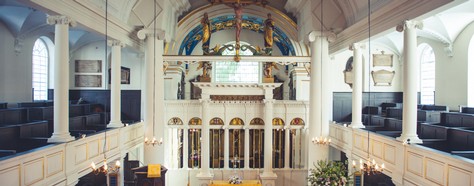 The first stone of the foundation was laid for the chapel on the 7th April, 1730 by Richard Grosvenor, the owner of the land. It had the classical parallelepiped shape with two rows of arched windows on the sides, a porch with four columns to the West, as well as a small tower with a clock and bells for summoning believers. The great organ built in the eighteenth-century style was placed in 1990 and concerts are often held here. The small church choir sing musical selections that range from the Renaissance to the present day. Lady Mary Montagu and Florence Nightingale used to come here often.
The first stone of the foundation was laid for the chapel on the 7th April, 1730 by Richard Grosvenor, the owner of the land. It had the classical parallelepiped shape with two rows of arched windows on the sides, a porch with four columns to the West, as well as a small tower with a clock and bells for summoning believers. The great organ built in the eighteenth-century style was placed in 1990 and concerts are often held here. The small church choir sing musical selections that range from the Renaissance to the present day. Lady Mary Montagu and Florence Nightingale used to come here often. Behind the church there is a peaceful green area, Mount Street Gardens, at the end of which, in Farm Street, there is a Catholic church of the Immaculate Conception, which was built halfway through the Nineteenth Century in the Medieval style. Pugin designed the main altar and the candelabra.
SHEPHERD MARKET SQUARE
UNDERGROUND: GREEN PARK
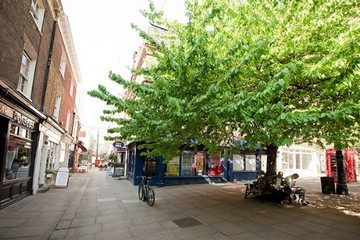 This is a small attractive square with many pubs, which make it lively also in the evening. It is the centre of Mayfair and bears the name of Edward Shepherd, who designed it and in doing so provided for the needs of the future residents by designing the shops, the market, a chapel, and a tavern. Because of this, it continues to look somewhat like a small village. Before a government act removed prostitutes from the streets, it had also become a red light district. It can be reached via Half Moon Street, which bears the shape that its name describes. In the square, there are also very unusual restaurants, such as a Lebanese eatery and a Polish-Mexican fast bistro restaurant, where one can eat at any time of the day or the night. There are also boutique shops, galleries, and specialty shops, such as the one selling toy soldiers. In the place where the May Fair used to be held, in 1735, the architect Shepherd was assigned with organizing the space in a different manner: paved avenues, a duck pond, a theatre, and a covered two-floor market, following the needs of the nearby houses.
This is a small attractive square with many pubs, which make it lively also in the evening. It is the centre of Mayfair and bears the name of Edward Shepherd, who designed it and in doing so provided for the needs of the future residents by designing the shops, the market, a chapel, and a tavern. Because of this, it continues to look somewhat like a small village. Before a government act removed prostitutes from the streets, it had also become a red light district. It can be reached via Half Moon Street, which bears the shape that its name describes. In the square, there are also very unusual restaurants, such as a Lebanese eatery and a Polish-Mexican fast bistro restaurant, where one can eat at any time of the day or the night. There are also boutique shops, galleries, and specialty shops, such as the one selling toy soldiers. In the place where the May Fair used to be held, in 1735, the architect Shepherd was assigned with organizing the space in a different manner: paved avenues, a duck pond, a theatre, and a covered two-floor market, following the needs of the nearby houses. At number 7, Shepherd Street, stands the Market Tavern pub, with its dark door and window frames and the indoor Baroque style, providing home cooking and good beer. Curzon Street is nearby and in it, the bookshop Heywood Hill.
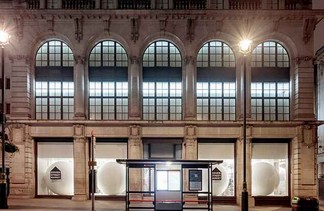 Dover Market – At number 17-18 of Dover Street, there is a very fascinating market, namely Dover Market, which includes six floors of a building. Its function is that of an innovative and artistic space. Signed clothing and accessories are sold here, as well as object and furniture, all of which are rather dear. However the environment and the installation which the items are exhibited in is so original (especially the shop windows) that it truly does deserve a visit. It feels almost akin to an artistic gallery, where fashion coexists alongside art and design. Behind it is the direction of Rei Kawakubo, a Japanese stylist who founded Comme des Garcons, and who wished to create an area where artists and style designers could gather to create an atmosphere of beauty and chaos. On the last floor is the little Rose Bakery, where it is quite a task to find a place during peak hours, but where it is possible to enjoy a delicious slice of carrot cake or quiche.
Dover Market – At number 17-18 of Dover Street, there is a very fascinating market, namely Dover Market, which includes six floors of a building. Its function is that of an innovative and artistic space. Signed clothing and accessories are sold here, as well as object and furniture, all of which are rather dear. However the environment and the installation which the items are exhibited in is so original (especially the shop windows) that it truly does deserve a visit. It feels almost akin to an artistic gallery, where fashion coexists alongside art and design. Behind it is the direction of Rei Kawakubo, a Japanese stylist who founded Comme des Garcons, and who wished to create an area where artists and style designers could gather to create an atmosphere of beauty and chaos. On the last floor is the little Rose Bakery, where it is quite a task to find a place during peak hours, but where it is possible to enjoy a delicious slice of carrot cake or quiche.REGENT STREET
UNDERGROUND: PICCADILLY CIRCUS, OXFORD CIRCUS
Along with the nearby Oxford Street, it is the shopping street par excellence. The large windows of the shops are simply wonderful, however it is during the Christmas period that the lighting and the decorations reach their greatest level of perfection. It has kept its English style, just as much as the nearby Soho feels foreign. In fact, Regent Street once had the precise task of setting a clear distinction between the neighbourhood of the rich aristocrats from that of the more modest houses of Soho, which had welcomed in waves of immigrants through the years. Regent Street gets its name from the prince regent, who later became King George IV, and was built to connect Westminster to the Royal Palace in Regent’s Park.
The street is associated with the name and work of the architect John Nash, although his buildings, with the exception of the church of All Souls, have all been replaced. The street, completed in 1825, represented the first attempt to arrange and organize the buildings both rationally and aesthetically, by using scientific, artistic, and social regulations and cognition which had been acquired at that time. In other words, it is a first example of urban planning, somewhat similar to what was carried out by the baron Haussman in Paris, who demolished thousands of decaying houses in order to construct the wide avenues which cut across the centre.

The graceful curvature of the Quadrant, which is still known as the southern extremity of the street, and goes from Vigo Street and Brewer Street to Piccadilly Circus, was one of the more prized elements of Nash’s design. Unfortunately the beautiful plaster facades and especially the porch have been destroyed. The former have been replaced with stone versions, which have a more lasting duration, whereas the colonnade has been eliminated because, according to the local merchants, it blocked the view of their shop windows, and in the more sheltered parts, seediness and squalor would prosper and undesirable characters would set up camp.
The shopping festival – During the month of September, the street hosts a festival which commemorates the origins of shopping. Every year brings with it a different theme. There is dancing and music; there are stands with food and beverages, as well as a reconstruction of a marketplace, tasting, special promotions in shops, and best of all, not a trace of a single car, as only pedestrians are allowed.
THE BRITISH DENTAL MUSEUM
64, WIMPOLE STREET
UNDERGROUND: OXFORD CIRCUS
The complete name of the tooth museum is the British Dental Association Museum. It is part of the Library of British dentists. Apparently it was only in 1921 that the dentist profession was regulated. One can only be happy about the progress made in the field of dentistry upon witnessing the rudimental tools, appliances, and materials once used: prosthetics were for example sculpted out of walrus or hippopotamus teeth. The collection includes over twenty thousand items, and tell the story of the evolution of this field, starting from the time when the only cure for teeth was extraction, often carried out on the market square, all the way to the complex procedures of our day and age, as well as the hygiene practice of tooth floss, pills for tooth pain, anaesthetics, and sophisticated drills. There are also some films on how dental hygiene has changed over time.

LIBERTY
REGENT STREET
UNDERGROUND: OXFORD CIRCUS
The activity of Liberty began in 1875 with a small emporium at 218, Regent Street, where oriental furniture and Chinese porcelain were sold. It had been opened by Arthur Lasenby Liberty, who amongst his clients counted celebrities such as Burne-Jones and Dante Gabriel Rossetti. The latter contributed towards making exotic objects become a fashion amongst rich Londoners, who were always on the lookout for eccentric novelty. When the business increased, Liberty started to sell unusual types of fabric which were to be matched with the exotic furniture. The furniture fabric which was used for dressing sofas, cushions, and other items was manufactured directly in his workshop.

In 1925, Captain Stewart Liberty, who had taken charge of its management, decided to assign the construction of a new building to the Hall architects, with the facade built in Portland stone. The building has large windows which face Regent Street. Yet the most unusual building belonging to Liberty is the one built in the Tudor style, which stands behind the first building, has black beams, and faces Great Marlborough Street. The two buildings are separated by Kingly Street, but are joined by an arched passage which hangs above the narrow street. The facade is decorated with a great clock bearing the figure of St George and the dragon. The inner cladding of this building has been recovered from the planking and cladding of the last two ships of the Royal Navy to have been built in this material, the HMS Hindustan, launched in 1824, and the HMS Impregnable, launched in 1865, the biggest in circulation. The inside area is structured in such a way as to have a great central hall and galleries on all sides which rest on thin pillars.
A BARBER SHOP FROM A TIME GONE BY
103, REGENT STREET
UNDERGROUND: PICCADILLY CIRCU
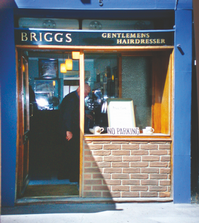 In the basement of Austin Reed, there is a barber shop with a charming Art Déco indoor design. This shop is filled with marble and metal plating, starting with those of the comfortable armchairs, and with its lamps in frosted glass, it has a dark and austere charm to it. Its enchanting appearance is further increased by the light which weaves in and around it, making it look somewhat like the set of a Hollywood musical. Well protected within the building’s core, it has survived almost completely intact throughout the years.
In the basement of Austin Reed, there is a barber shop with a charming Art Déco indoor design. This shop is filled with marble and metal plating, starting with those of the comfortable armchairs, and with its lamps in frosted glass, it has a dark and austere charm to it. Its enchanting appearance is further increased by the light which weaves in and around it, making it look somewhat like the set of a Hollywood musical. Well protected within the building’s core, it has survived almost completely intact throughout the years. CARNABY STREET
UNDERGROUND: OXFORD CIRCUS
Today Carnaby Street is a street like any other, coasted by clothes shops with a rather casual and scruffy style to them. Its best asset is the fact of being a pedestrian street. The magic of the Sixties has all but disappeared, a time during which its name evoked a new culture, young and rebellious. At its extremities, there are arch-shaped signs with the name of the street in capital letters. The boutiques of modern clothing indicate that rather than being independent, they belong to the big brands and chains.
The name comes from Karnaby House, which stood here in 1683, although it is not clear exactly why it bore such a name. It was after the end of the Fifties that strangely-named boutiques started to pop up in the street: His Clothes, I Was Lord Kitchener’s Valet, Mr Fish, Kleptomania, Mates… In the Sixties, the hippies and the Vespa-riding mods would come here to resupply, having created a new clothing fashion of their own.

The winning idea of stylists at the time was that of providing men’s fashion with the same amount of attention that was given to female fashion, by rejuvenating it and enriching it with clothing items which were not part of the traditional outfit. Also Mary Quant, the inventor of the miniskirt, had a shop here. The success of these new trends in clothing styles went hand in hand with that of emergent musical bands, such as the Beatles, the Rolling Stones, and the Who, who would all be scheduled to play at the Marquee Club in Wardour Street. This was how the famed Swinging London got its name, the lively city of the Sixties.
It is a neighbourhood where it is pleasant to wander about taking in the surrounding sights. Many shops have changed their image and modernized, but the facades of many houses, on the first and second floor, have maintained their appearance of long ago. Here, there are none of the elegant buildings of Regent Street, but only small and modest houses, which tell the story of those who arrived here desperate and needy, with the necessity to create a new life for themselves.
The bizarre name Soho appeared for the first time in 1636 in the price lists of the parish of St Martin. It would seem to derive from a hunting call used when a hare was flushed out of its den. It is a neighbourhood which throughout the centuries has welcomed immigrants from France, Italy, India, China, and Ireland. The latter, in 1693, built the church of St Patrick, with a tall and imposing bell tower. Many have opened restaurants and artisan activities such as bookbinding, typography, framing laboratories, or manufacturing of musical instruments, which can still be found today. Soho has always been a different place and not a very English one, and has also welcomed in political refugees. The French community increased enormously after 1685, when Louis XIV revoked the Nantes edict, which had guaranteed freedom of cult to Huguenots. Charles II declared that they were to have the same rights to live and trade in England, and so it was that fifty thousand of them crossed over the Channel to reach England. Soho is a neighbourhood where there is a lot of movement and in order to enjoy a little peace, one should go there on a Saturday or Sunday morning.

A long time ago, Soho Square was called King’s Square, perhaps in honour of King Charles II, who is portrayed in the centre of a group of sculptures, surrounded by the statues of the Thames, the Severn, the Tyne, and the Humber. It is a tree-lined square, and in the summer free concerts are held in the garden.
The French refugees had their Protestant church here, near the Catholic church of St Patrick. The small pseudo-Tudor building built in wood, both picturesque and clearly from time long gone, looks like it was taken from a fable written by the Brothers Grimm, and is used as shelter for the guardian of the park, as well as a deposit for tools.
In the month of July, the Soho Festival takes place, and is rather old-fashioned, seeming more like a country market fair. It takes place in the gardens of St Anne’s Square, near Wardour Street. There are some plays enacted by male actors dressed as women and vice versa, Chinese food, and musical bands…
SHAFTESBURY AVENUE
UNDERGROUND: PICCADILLY CIRCUS
Shaftesbury Avenue was opened during the second half of the Nineteenth Century by the engineer Bazalgette and the architect Vulliamy, in order to connect New Oxford Street with Piccadilly. It was the result of an act to clean out the slums, which had the result of pushing the poorer people further away from the centre, relocating them to more peripheral areas. Today the avenue is the centre of West End, a street of theatres. Right next to each other are the Lyric, the Apollo, the Gielgud, and the Queen’s, as well as the homonymous theatre, which stands at the north-eastern extremity. In the spot where Shaftesbury Avenue connects with Charing Cross Road, stands the Palace Theatre.
The street also borders London’s Chinatown, with its numerous Chinese medical facilities, restaurants, supermarkets, travel agencies, cellular phone outlets, bakeries, hairdressers, fishmongers, newsagents, exchange offices, and banks…
In the evening, on the pavement in front of the Nat West bank, towards Piccadilly, there are street artists and painters portraying passers-by in charcoal drawings.
The street is dedicated to Anthony Ashley Cooper, count of Shaftesbury, also an industrial entrepreneur, politician, and philanthropist. No sooner was he elected in Parliament amid the ranks of the Tories, than he commenced a series reforms in factories and mines. One of his main preoccupations was the well-being of children. He was a fervid supporter of Florence Nightingale. The Eros of Piccadilly Circus, which is in fact The Angel of Christian Charity, is dedicated to him.

Chinese Cuisine – In Gerrard Street, at number 9, stands the New Loon Moon, which offers a wide choice of Asian dishes. At number 42 in the same street, there is an oriental supermarket, known as Loon Fung, where it is most fascinating to browse through the products on sale. The same can be said for the Good Harvest Fish Market at 65, Shaftesbury Avenue. Furthermore, at number 25 of the nearby Newport Court, with its rather kitsch interior, one can purchase some excellent “street food” for a cheap price, such as baozi, which consists of steamed bread filled with meat and vegetables, with an optional side dish of soup or noodles which have been freshly made on the premises.
The small red-brick building at number 136, Shaftesbury Avenue, which now hosts the Walkabout bar, has an unusual history to it. It was built in 1890 to host a Welsh Presbyterian church. In the Eighties it was reconverted into a dance club, the Limelight. In 2003 its popularity abated, and it was then reconverted into a pub, where a crowd of regular customers gather to watch matches on the big screen.
One may also visit Oscar Wilde’s favourite restaurant, the Kettner’s, in Romilly Street 29, founded in 1867 by Auguste Kettner, the personal chef of Napoleon III, and here one may also drink a glass of champagne.
THE HOUSE OF ST BARNABAS
1, GREEK STREET
UNDERGROUND: TOTTENHAM COURT ROAD
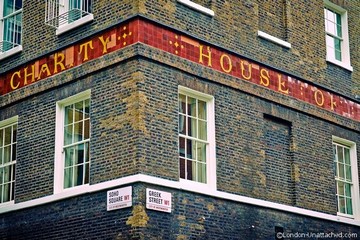 This charity house (Barnabas was the “Son of Consolation”) was formed in 1846 for assisting the poor and homeless of London. The indoor area is magnificent, with splendid ceilings decorated with plaster bas-reliefs portraying cherubs and flower themes. There is also a chapel, and it is mentioned in the sixth chapter of Dickens’ work A Story of Two Cities, where he mentions a sycamore tree which is in the courtyard still today. The institution continues its meritorious work to date.
This charity house (Barnabas was the “Son of Consolation”) was formed in 1846 for assisting the poor and homeless of London. The indoor area is magnificent, with splendid ceilings decorated with plaster bas-reliefs portraying cherubs and flower themes. There is also a chapel, and it is mentioned in the sixth chapter of Dickens’ work A Story of Two Cities, where he mentions a sycamore tree which is in the courtyard still today. The institution continues its meritorious work to date.GREEK STREET
UNDERGROUND: TOTTENHAM COURT ROAD
The Greek Orthodox refugees arrived here at the end of 1700, in an attempt to flee the Turkish. A church was built for them upon the area where St Martin’s School of Art now stands. Today the street is famous for its oriental, middle-eastern, Italian, and French restaurants (L’Escargot, at number 48, which can be found on the Michelin Guide), as well as pizzerias, bars, and art galleries. It was originally called Hogs Lane, then in 1679 it took on its current name. It is believed that the name derives from a Greek church which was here, and which was painted by William Hogarth in a painting of his. At number 1, there used to be headquarters for the sewage commission, where Bazalgette worked, which later became a shelter the homeless. Even the writer and essayist Thomas de Quincy sought refuge here in misery.
FRITH STREET AND THE BAR ITALIA
UNDERGROUND: LEICESTER SQUARE
The name of the street derives from that of its builder, Richard Frith, owner of the land around Soho Fields. For a time, the painter John Constable lived here. At number 6 lived the essayist and critic William Hazlitt, who also died here whilst uttering the words “Good, I have had a happy life”, despite the fact that his life had also been rather argumentative. In Autumn 1764, Mozart, who was eight years old, stayed at number 20.

He succeeded in surprising the King and high society with his talent delivered at 21 Dean Street.
If you are nostalgic for a great espresso coffee, then this is the place to come. It is usually rather crowded when the Italian soccer team is playing in a match. The blue plaque on the facade is in memory of the fact that on 27th January 1926, John Logie Baird gave the first demonstration of a television at number 22 of this street, exactly in the place where the Bar Italia is today. The bar is open till late, and one can taste some good ice cream and pizza here.
The famous venue called Ronnie Scott’s Jazz Club can be found at number 47.
DEAN STREET AND MARX’S HOUSE
UNDERGROUND: TOTTENHAM COURT ROAD
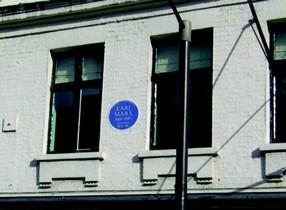 This street is rich with history, and the French House is located here, headquarters of the French resistance during the Second World War. In this street, between 1851 and 1856, Karl Marx also lived here, with his wife, who was a baroness, and their five children. Their two rooms were above the restaurant Quo Vadis, which still exists today. It was in a house in this very street that Admiral Nelson spent his last night before the battle of Trafalgar, where he lost his life. At number 88 there stands a pretty shop facade, with small pillars dividing it into four parts. Above them, there is a curved strip decorated with panels which have been inserted into rococo frames.
This street is rich with history, and the French House is located here, headquarters of the French resistance during the Second World War. In this street, between 1851 and 1856, Karl Marx also lived here, with his wife, who was a baroness, and their five children. Their two rooms were above the restaurant Quo Vadis, which still exists today. It was in a house in this very street that Admiral Nelson spent his last night before the battle of Trafalgar, where he lost his life. At number 88 there stands a pretty shop facade, with small pillars dividing it into four parts. Above them, there is a curved strip decorated with panels which have been inserted into rococo frames.SOHO THEATRE
21, DEAN STREET
UNDERGROUND: TOTTENHAM COURT ROAD This small theatre, restored in modern times, presents new theatrical works, comedies which are entertaining or politically and socially active, educational programs, and cabaret. It is the headquarters of a centre which aids and prepares young writers to become theatre authors and playwrights. There are one hundred and fifty wooden seats with cushions, the atmosphere is informal, and the environment cosy. The stage has quite a depth to it, and can be easily transformed. With a ticket for a show, one also receives a 10% discount at the bar, which is above the restaurant. If one purchases a theatre package, one may dine at the Indian Lazeez restaurant in the underground area, which offers delicious fusion cuisine amid modern deco with music in the background. At number 55 in the same street, stands St Anne’s church, consecrated in 1686, but almost destroyed by the bombing in 1940.
We mention it due to its connection with the writer of detective stories, Dorothy Sayers, who was its churchwarden. Amongst the tombs of the small cemetery lies that of Theodore, known as King of Corsica, whose epitaph was composed by none other than Horace Walpole.

WARDOUR STREET
UNDERGROUND: OXFORD CIRCUS
The street bears the name of Archibald Wardour, the architect who built a number of buildings upon it. At numbers 152-160 there is a pretty building which was designed in 1906 by Pearson for Novello & Co, the music publishers. Along the trabeation one can make out the name intertwined with leaves. The company moved in 1965. The marble statue of Händel, carried out by Roubiliac, which used to be within a recess at the top of the stairway, is now held at the Victoria & Albert Museum. There are a great deal of music shops on this street and in the vicinity. At number 142, one can find the headquarters of the London branch of the Pathé Film.

Amid the dozens of restaurants to be found in this street, we shall mention the Chinese Wong Kei, which stands at number 41-43, and which can seat up to five hundred customers. The building which it is part of has a pretty facade in bricks and stones in hues of green and white, which combines the Baroque style with Art Nouveau. It once belonged to Willy Clarkson, a costume designer and manufacturer of theatrical wigs, as stated by the plaque on the facade. Another plaque reminds us of the fact that in 1904 Sarah Bernhardt laid down its founding stone.
If one prefers middle-eastern cuisine, at number 88 one can visit Hummus Bros, where the famous chick pea cream is served on pita bread and comes with mushrooms, guacamole, meat, and beans. The dessert known as baklava, which consists of walnuts wrapped in crunchy flaky pastry and covered in honey, can also be found here.
The name of the street has even entered the English language with the expression Wardour Street prose, which indicates the use of rather obsolete terms, such as anent, for example, which refers to the great number of antiquary shops in the area.
A PINT IN A CELL
UNDERGROUND: PICCADILLY CIRCUS, OXFORD CIRCUS
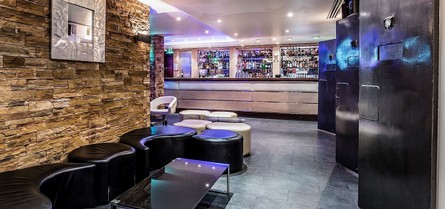 Berwick Street, which further south becomes Rupert Street, was built in 1687 on land conceded by James Pollett, a Catholic who in all likelihood gave it such a name in honour of the royal catholic house of the Stuarts. The Duke of Berwick, in fact, was the youngest son of James II of House Stuart. For over three hundred years, from Monday to Saturday, a small and quaint fruit market has been held in this street. The flower stands, with their old-fashioned signs, give it a sense of nostalgia. Two pleasant little stalls are the one selling nuts and Japanese crackers, and another which sells Malaysian fast food, including chicken rice. The market was born together with the street, in the early Eighteenth Century, although it was not recognized until the end of the Nineteenth Century. There are also some wonderful gastronomy shops, with a number of delicacies on offer. The street also hosts a number of recording studios, in fact it is even featured on the cover of the Oasis album (What’s the Story), Morning Glory?
Berwick Street, which further south becomes Rupert Street, was built in 1687 on land conceded by James Pollett, a Catholic who in all likelihood gave it such a name in honour of the royal catholic house of the Stuarts. The Duke of Berwick, in fact, was the youngest son of James II of House Stuart. For over three hundred years, from Monday to Saturday, a small and quaint fruit market has been held in this street. The flower stands, with their old-fashioned signs, give it a sense of nostalgia. Two pleasant little stalls are the one selling nuts and Japanese crackers, and another which sells Malaysian fast food, including chicken rice. The market was born together with the street, in the early Eighteenth Century, although it was not recognized until the end of the Nineteenth Century. There are also some wonderful gastronomy shops, with a number of delicacies on offer. The street also hosts a number of recording studios, in fact it is even featured on the cover of the Oasis album (What’s the Story), Morning Glory?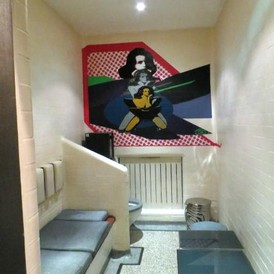 The court cells – The café of the Courthouse Hotel, which is at number 19-21 of Great Marlborough Street, is situated at the back of the building. Especially interesting is the fact that it has been setup within what were once the cells of the court custody. The venue is quite spartan, with white walls, a stone bed (the so-called hard bunk), which has been turned into a sofa with the aid of some large dark brown cushions, and a cold and extremely powerful neon light. The door still has a peephole on it, through which guards would supervise prisoners awaiting judgement. One can order a pint of beer, a cocktail, or a glass of wine along with a snack or some delicious sandwiches.
The court cells – The café of the Courthouse Hotel, which is at number 19-21 of Great Marlborough Street, is situated at the back of the building. Especially interesting is the fact that it has been setup within what were once the cells of the court custody. The venue is quite spartan, with white walls, a stone bed (the so-called hard bunk), which has been turned into a sofa with the aid of some large dark brown cushions, and a cold and extremely powerful neon light. The door still has a peephole on it, through which guards would supervise prisoners awaiting judgement. One can order a pint of beer, a cocktail, or a glass of wine along with a snack or some delicious sandwiches. The nearby Beak Street, to the south, bears the name of Thomas Beak, who in 1673 purchased the land between what is now Regent Street and Kingly Street, where the street was later built. Canaletto once lived at number 41, Beak Street, during the ten years of his stay in London.
LEICESTER SQUARE
UNDERGROUND: LEICESTER SQUARE
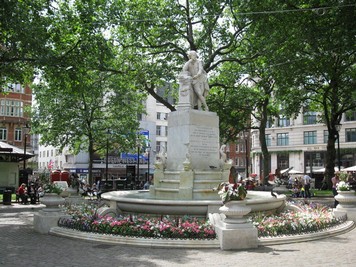 It is one of the areas of greatest passage for tourists, and therefore many street sellers can be found here, pitching hot dogs and chips. The smell of vinegar and ketchup which they are dressed with in their paper cornet is one of the first things that one perceives as one exits the tube station. Even sparrows and crows follow this odorous trail, and unabashedly approach people to have their part of the meal. Another reason for this square being so crowded is the presence of so many cinemas. Because of this, in order to make the most of it, it is advisable to visit the square in the morning, when the long lines of customers waiting to enter the cinemas have not yet formed, and one has some hope of getting to sit in the gardens for a little. The square gets its name from the Leicester House, the construction of which was ordered in 1631 by the Duke of Leicester in the spot where the Empire cinema now stands. At the time it was a Lammas Land, that is to say a grassy area where those belonging to a parish would bring their cattle to graze, and where women would hang the laundry. The origin of the square also explains its rather irregular shape. At the beginning of the Nineteenth Century, it was in a state of abandon, however the minister Disraeli and his government restored it and had elms planted in it, which are still those found there today.
It is one of the areas of greatest passage for tourists, and therefore many street sellers can be found here, pitching hot dogs and chips. The smell of vinegar and ketchup which they are dressed with in their paper cornet is one of the first things that one perceives as one exits the tube station. Even sparrows and crows follow this odorous trail, and unabashedly approach people to have their part of the meal. Another reason for this square being so crowded is the presence of so many cinemas. Because of this, in order to make the most of it, it is advisable to visit the square in the morning, when the long lines of customers waiting to enter the cinemas have not yet formed, and one has some hope of getting to sit in the gardens for a little. The square gets its name from the Leicester House, the construction of which was ordered in 1631 by the Duke of Leicester in the spot where the Empire cinema now stands. At the time it was a Lammas Land, that is to say a grassy area where those belonging to a parish would bring their cattle to graze, and where women would hang the laundry. The origin of the square also explains its rather irregular shape. At the beginning of the Nineteenth Century, it was in a state of abandon, however the minister Disraeli and his government restored it and had elms planted in it, which are still those found there today.
William Shakespeare and the dolphins – Amongst the statues that decorate the garden, there is one especially attractive one dedicated to William Shakespeare, who is surrounded by dolphins. At its four corners, where the entrance gates stand, there are four busts. One of them portrays Joshua Reynolds, the great painter of portraits from the time of King George III, as well as the first president of the Royal Academy of Arts. Reynolds lived in number 47 of the square and on the ground floor of this address he had opened a gallery where he would exhibit his paintings, which was often visited by important characters such as James Boswell, David Garrick, Fanny Burney, and Edmund Burke. Unfortunately, his statue was ruined by a flawed restoration intervention and the lines of the face were partly erased. To blame for the corrosion was a stain remover liquid, which also contained an acid. Beneath it a motto recites: “Learn to forget that you ever remembered”. Also the painter William Hogarth lived here, at number 30, and he too is commemorated with a statue, as is the scientist Isaac Newton, also a resident in this square. The last bust represents John Hunter, a pioneer in the field of surgery. There is also a bronze statue of Charlot, which is surrounded by a few peculiar plaques, which show the distance in miles from a number of countries which used to belong to the British Empire. One learns, for instance, that Leicester Square and Dhaka, in Bangladesh, are eight thousand kilometres apart.
JEAN COCTEAU AT THE NOTRE DAME CHURCH
5, LEICESTER PLACE
UNDERGROUND: LEICESTER PLACE
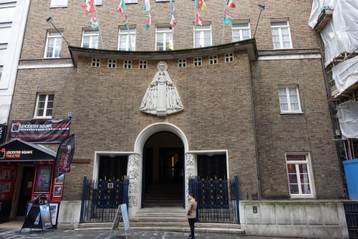 In the spot where the church now stands, there was once the panorama building, carried out by Robert Barker, a travelling painter who used to exhibit large paintings of cities and natural landscapes here. He would arrange the canvases in a circular fashion and his idea met with great success. The spectators would stand at the centre of the iron structure and slowly be turned so that they could admire the great views of cities such as Edinburgh and English landscapes. The effect was similar to what we might experience nowadays by looking at a photograph taken with a wide-angle lens and placed in such a way as to form a ring. These large canvases were very popular still at the beginning of the Twentieth Century, and a painter by the name of John James Story from Nottingham, even painted the life and career of Giuseppe Garibaldi in forty-two scenes of his life and battles, later arranged in chronological order.
In the spot where the church now stands, there was once the panorama building, carried out by Robert Barker, a travelling painter who used to exhibit large paintings of cities and natural landscapes here. He would arrange the canvases in a circular fashion and his idea met with great success. The spectators would stand at the centre of the iron structure and slowly be turned so that they could admire the great views of cities such as Edinburgh and English landscapes. The effect was similar to what we might experience nowadays by looking at a photograph taken with a wide-angle lens and placed in such a way as to form a ring. These large canvases were very popular still at the beginning of the Twentieth Century, and a painter by the name of John James Story from Nottingham, even painted the life and career of Giuseppe Garibaldi in forty-two scenes of his life and battles, later arranged in chronological order.
The current building was reconstructed in 1955 by the architects Corfiato and Lloyd Thomason, who conserved the ring-shaped structure. The interior is tall and spacious and decorated by panels, like those placed above the pillars between the door compartments, which contain scenes of the life of the Virgin Mary carried out by the students of the Beaux-Arts of Paris. There are bas-reliefs and, above the main entrance, a statue made by Georges Saupique which depicts the Mater Misericordiae. There is also an enormous tapestry by Robert de Chaunac portraying Mary, Our Lady of Creation. Yet the most famous paintings are those which date back to 1960 on the walls of the chapel of the Madonna by Jean Cocteau. There are various themes: the Assumption and the Crucifixion, where only Christ’s feet can be seen, while beneath the cross, the soldiers play to win Jesus’ tunic in a game of dice.
CHARING CROSS,
THE STREET OF BOOKSHOPS
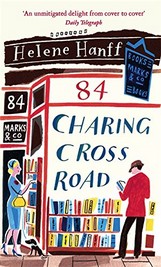 Charing Cross Road is the street which marks the border of Soho to the East, and leads to the cross which used to be at the crossroads between Strand and Northumberland Avenue. Under the grid at the centre of the junction between Charing Cross Road and Old Compton Street there are still some old traffic signs of Little Compton Street, a street which no longer exists. Charing Cross Road is known by readers for its numerous bookshops, both of the generalized and specialized type, which offer books about art, second hand books, or antique items. Amongst them are Quinto, Pordes, and Any Amount of Books. A few years ago, the construction cooperatives which own the shops’ premises decided to raise the rents of many of these buildings. This forced many shops, such as Silver Moon, the women’s book shop, to move to the last floor of Foyles.
Charing Cross Road is the street which marks the border of Soho to the East, and leads to the cross which used to be at the crossroads between Strand and Northumberland Avenue. Under the grid at the centre of the junction between Charing Cross Road and Old Compton Street there are still some old traffic signs of Little Compton Street, a street which no longer exists. Charing Cross Road is known by readers for its numerous bookshops, both of the generalized and specialized type, which offer books about art, second hand books, or antique items. Amongst them are Quinto, Pordes, and Any Amount of Books. A few years ago, the construction cooperatives which own the shops’ premises decided to raise the rents of many of these buildings. This forced many shops, such as Silver Moon, the women’s book shop, to move to the last floor of Foyles.
In the pedestrian cross street of Cecil Court, there are antique book shops, amongst which one selling Italian books. In the northern part of the street stands Foyles (at numbers 113-119) and Blackwell’s, while to the south is Zwemmers, specialized in art books. The street has been even described in a book of great success, of which a film was made, namely 84, Charing Cross Road, written in 1970, which tells of the long correspondence between the American Helene Hanff and the employees of the book shop Marks & Co.
If you desire a good espresso, you can visit Caffé Vergnano, at 62, Charing Cross Road, which opened in 1882. An excellent Italian coffee is served here, and it attracts people from all over the world.
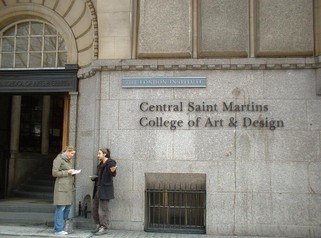 A designer school – Number 102, Charing Cross Road hosts the St Martins College of Art and Design, the most important school of Art and Design in all of Great Britain, which also gives a substantial contribution to the fashion industry. The school was founded in 1896, as an emanation of the Arts and Crafts movement, sponsored by William Morris and John Ruskin.
A designer school – Number 102, Charing Cross Road hosts the St Martins College of Art and Design, the most important school of Art and Design in all of Great Britain, which also gives a substantial contribution to the fashion industry. The school was founded in 1896, as an emanation of the Arts and Crafts movement, sponsored by William Morris and John Ruskin. The great building that hosts it has many decorations engraved in the stone of its facade.
Within its halls, contemporary and historical collections are held, and include books, printed material, and works of art and design. Two of its more famous pupils are Lucian Freud and Eduardo Paolozzi.

